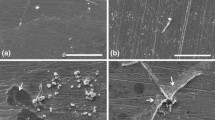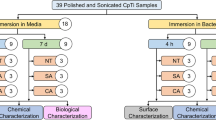Abstract
It is well known that some microorganisms affect the corrosion of dental metal. Oral bacteria such as Actinomyces naeslundii may alter the corrosion behavior and stability of titanium. In this study, the corrosion behavior of titanium was studied in a nutrient-rich medium both in the presence and the absence of A. naeslundii using scanning electron microscopy (SEM), X-ray photoelectron spectroscopy (XPS), and electrochemical impedance spectroscopy (EIS). A. naeslundii was able to colonize the surface of titanium and then form a dense biofilm. The SEM images revealed the occurrence of micropitting corrosion on the metal surface after removal of the biofilm. The electrochemical corrosion results from EIS showed a significant decrease in the corrosion resistant (Rp) value after immersing the metal in A. naeslundii culture for 3 days. Correspondingly, XPS revealed a reduction in the relative levels of titanium and oxygen and an obvious reduction of dominant titanium dioxide (TiO2) in the surface oxides after immersion of the metal in A. naeslundii culture. These results suggest that the metabolites produced by A. naeslundii can weaken the integrity and stability of the protective TiO2 in the surface oxides, which in turn decreases the corrosion resistance of titanium, resulting in increased corrosion of titanium immersed in A. naeslundii solution as a function of time.







Similar content being viewed by others
References
Broggini N, Mcmanus LM, Hermann JS, Medina R, Schenk RK, Buser D, Cochran DL. Peri-implant inflammation defined by the implant–abutment interface. J Dent Res. 2006;85:473.
Gil FJ, Rodriguez A, Espinar E, Llamas JM, Padulles E, Juarez A. Effect of oral bacteria on the mechanical behavior of titanium dental implants. Int J Oral Maxillofac Implants. 2012;27:64.
Souza JC, Henriques M, Oliveira R, Teughels W, Celis JP, Rocha LA. Do oral biofilms influence the wear and corrosion behavior of titanium? Biofouling. 2010;26:471.
Passariello C, Puttini M, Virga A, Gigola P. Microbiological and host factors are involved in promoting the periodontal failure of metaloceramic crowns. Clin Oral Investig. 2011;16(3):987–95.
Wylie CM, Shelton RM, Fleming GJ, Davenport AJ. Corrosion of nickel-based dental casting alloys. Dent Mater. 2007;23:714.
Bahije L, Benyahia H, El Hamzaoui S, Ebn Touhami M, Bengueddour R, Rerhrhaye W, Abdallaoui F, Zaoui F. Behavior of NiTi in the presence of oral bacteria: corrosion by Streptococcus mutans. Int Orthod. 2011;9:110.
Papadopoulou K, Eliades T. Microbiologically-influenced corrosion of orthodontic alloys: a review of proposed mechanisms and effects. Aust Orthod J. 2009;25:63.
Satoh H, Odagiri M, Ito T, Okabe S. Microbial community structures and in situ sulfate-reducing and sulfur-oxidizing activities in biofilms developed on mortar specimens in a corroded sewer system. Water Res. 2009;43:4729.
Rodriguez-Hernandez AG, Juarez A, Engel E, Gil FJ. Streptococcus sanguinis adhesion on titanium rough surfaces: effect of shot-blasting particles. J Mater Sci Mater Med. 2011;22:1913.
Scarano A, Piattelli M, Caputi S, Favero GA, Piattelli A. Bacterial adhesion on commercially pure titanium and zirconium oxide disks: an in vivo human study. J Periodontol. 2004;75:292.
Teughels W, Van Assche N, Sliepen I, Quirynen M. Effect of material characteristics and/or surface topography on biofilm development. Clin Oral Implants Res. 2006;17(Suppl 2):68.
Kanematsu H, Ikigai H, Yoshitake M. Evaluation of various metallic coatings on steel to mitigate biofilm formation. Int J Mol Sci. 2009;10:559.
Boudaud N, Coton M, Coton E, Pineau S, Travert J, Amiel C. Biodiversity analysis by polyphasic study of marine bacteria associated with biocorrosion phenomena. J Appl Microbiol. 2010;109:166.
Carlen A, Nikdel K, Wennerberg A, Holmberg K, Olsson J. Surface characteristics and in vitro biofilm formation on glass ionomer and composite resin. Biomaterials. 2001;22:481.
Balkin Twr BE, Feik D, Molzan AK, Ram TE. Microbiology of human mandibular subperiosteal dental implants in health and disease. J Dent Res. 2000;79:168.
Scarano A, Assenza B, Piattelli M, Iezzi G, Leghissa GC, Quaranta A, Tortora P, Piattelli A. A 16-year study of the microgap between 272 human titanium implants and their abutments. J Oral Implantol. 2005;31:269.
Jakubovics NS, Gill SR, Vickerman MM, Kolenbrander PE. Role of hydrogen peroxide in competition and cooperation between Streptococcus gordonii and Actinomyces naeslundii. FEMS Microbiol Ecol. 2008;66:637.
Kitada K, Oho T. Effect of saliva viscosity on the co-aggregation between oral streptococci and Actinomyces naeslundii. Gerodontology. 2011;29(2):e981–7.
Yu WQ, Qiu J, Xu L, Zhang FQ. Corrosion behaviors of TiO2 nanotube layers on titanium in Hank’s solution. Biomed Mater. 2009;4:065012.
Yu WQ, Qiu J, Zhang FQ. In vitro corrosion study of different TiO2 nanotube layers on titanium in solution with serum proteins. Colloids Surf B. 2011;84:400.
Al-Ahmad A, Wiedmann-Al-Ahmad M, Faust J, Bachle M, Follo M, Wolkewitz M, Hannig C, Hellwig E, Carvalho C, Kohal R. Biofilm formation and composition on different implant materials in vivo. J Biomed Mater Res B. 2010;95:101.
Gibbons RJ. Bacterial adhesion to oral tissues: a model for infectious diseases. J Dent Res. 1989;68:750.
Gibbons RJ, Hay DI. Adsorbed salivary acidic proline-rich proteins contribute to the adhesion of Streptococcus mutans JBP to apatitic surfaces. J Dent Res. 1989;68:1303.
Gibbons RJ, Hay DI, Cisar JO, Clark WB. Adsorbed salivary proline-rich protein 1 and statherin: receptors for type 1 fimbriae of Actinomyces viscosus T14 V-J1 on apatitic surfaces. Infect Immun. 1988;56:2990.
Qiu J, Yu WQ, Zhang FQ. Effects of the porcelain-fused-to-metal firing process on the surface and corrosion of two Co–Cr dental alloys. J Mater Sci. 2011;46:1359.
Sharma M, Kumar Av, Singh N. Electrochemical corrosion behaviour of dental/implant alloys in saline medium. J Mater Sci Mater Med. 2008;19:2647.
Metikos-Hukovic M, Pilic Z, Babic R, Omanovic D. Influence of alloying elements on the corrosion stability of CoCrMo implant alloy in Hank’s solution. Acta Biomater. 2006;2:693.
Takahashi N, Yamada T. Glucose and lactate metabolism by Actinomyces naeslundii. Crit Rev Oral Biol Med. 1999;10:487.
Pope DH, Duquette DJ, Johannes AH, Wayner PC. Microbiologically influenced corrosion of industrial alloys. Mater Perform. 1984;4:14.
Palaghias G. Corrosion of dental amalgams in solutions of sodium chloride, sodium sulfide and ammonia. Scand J Dent Res. 1986;94:274.
Bilhan H, Bilgin T, Cakir AF, Yuksel B, Von Fraunhofer JA. The effect of mucine, IgA, urea, and lysozyme on the corrosion behavior of various non-precious dental alloys and pure titanium in artificial saliva. J Biomater Appl. 2007;22:197.
Acknowledgments
This investigation was supported by the National Natural Science Foundation of China (Project Number: 81201201 and 81200265), by the Natural Science Foundation of Higher Education Institutions of Jiangsu Province (Project Number: 11KJB320004), and by the Shanghai Leading Academic Discipline Project (Project Number: T0202).
Author information
Authors and Affiliations
Corresponding authors
Additional information
Song-Mei Zhang and Jing Qiu contributed equally to this study.
Rights and permissions
About this article
Cite this article
Zhang, SM., Qiu, J., Tian, F. et al. Corrosion behavior of pure titanium in the presence of Actinomyces naeslundii . J Mater Sci: Mater Med 24, 1229–1237 (2013). https://doi.org/10.1007/s10856-013-4888-3
Received:
Accepted:
Published:
Issue Date:
DOI: https://doi.org/10.1007/s10856-013-4888-3




